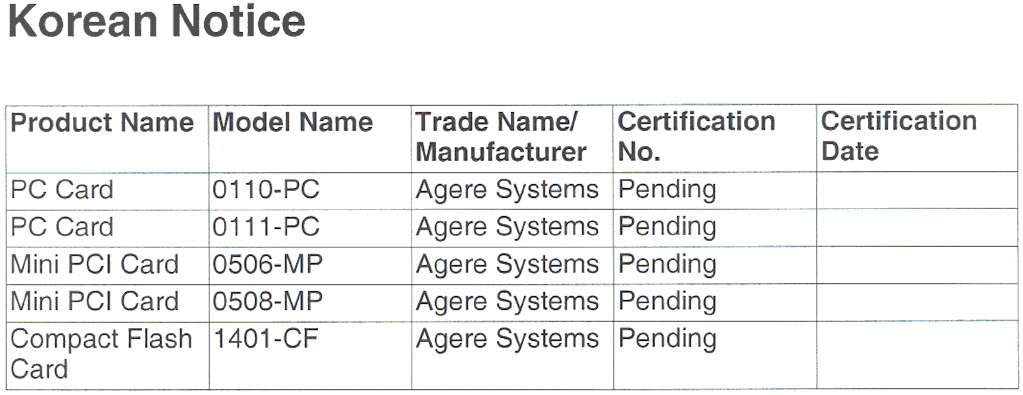Agere Systems Nederland PC2411B Wireless LAN PC Card 2.4 GHz User Manual Current Users Manual
Agere Systems Nederland B.V. Wireless LAN PC Card 2.4 GHz Current Users Manual
Contents
- 1. Users Manual
- 2. Current Users Manual
- 3. Flyer
Current Users Manual

It is the policy of Agere Systems Inc. to provide customers with the Iatest available
information. AII updates to this document will appear in the English version first.
This document provides regulatory information about Agere wireless LAN products.
This product uses Direct Sequence Spread Spectrum (DSSS) radio technology. It is
designed to be inter-operable with any other wireless DSSS type product that
complies with:
. The IEEE 802.11 b Standard on Wireless LANs, as defined and approved
by the Institute of Electrical and Electronics Engineers.
. The Wireless Fidelity (Wi-Fi) certification as defined by the Wi-Fi Alliance,
formerly known as WECA (Wireless Ethernet Compatibility Alliance).
For the country and date of manufacturing, consult the identification label of your
wireless device.
Wireless LAN products are radio devices that emit radio frequency electromagnetic
energy. The level of energy emitted by Wireless LAN devices is much less than the
electromagnetic energy emitted by devices like for example mobile phones.
Because Wireless LAN products operate within the guidelines found in radio
frequency safety standards and recommendations, Agere believes this product is
safe for use by consumers. These standards and recommendations reflect the
consensus of the scientific community and result from deliberations of panels and
committees of scientists who continually review and interpret the extensive research
literature.
1
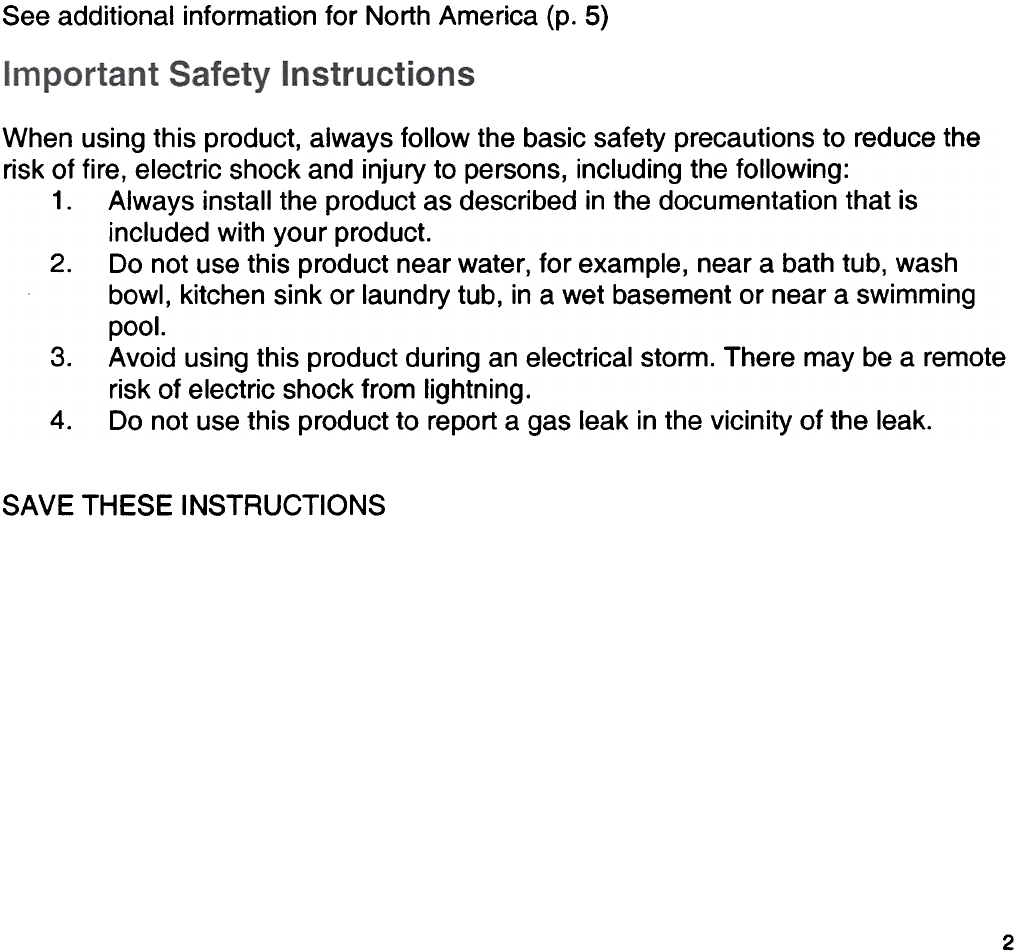
See additional intormation tor North America (p. 5)
When using this product, always follow the basic safety precautions to reduce the
risk of fire, electric shock and injury to persons, including the following:
1 . Always install the product as described in the documentation that is
included with your product.
2. Do not use this product near water, for example, near a bath tub, wash
bowl, kitchen sink or laundry tub, in a wet basement or near a swimming
pool.
3. Avoid using this product during an electrical storm. There may be a remote
risk of electric shock from lightning.
4. Do not use this product to report a gas leak in the vicinity of the leak.
SAVE THESE INSTRUCTIONS
2
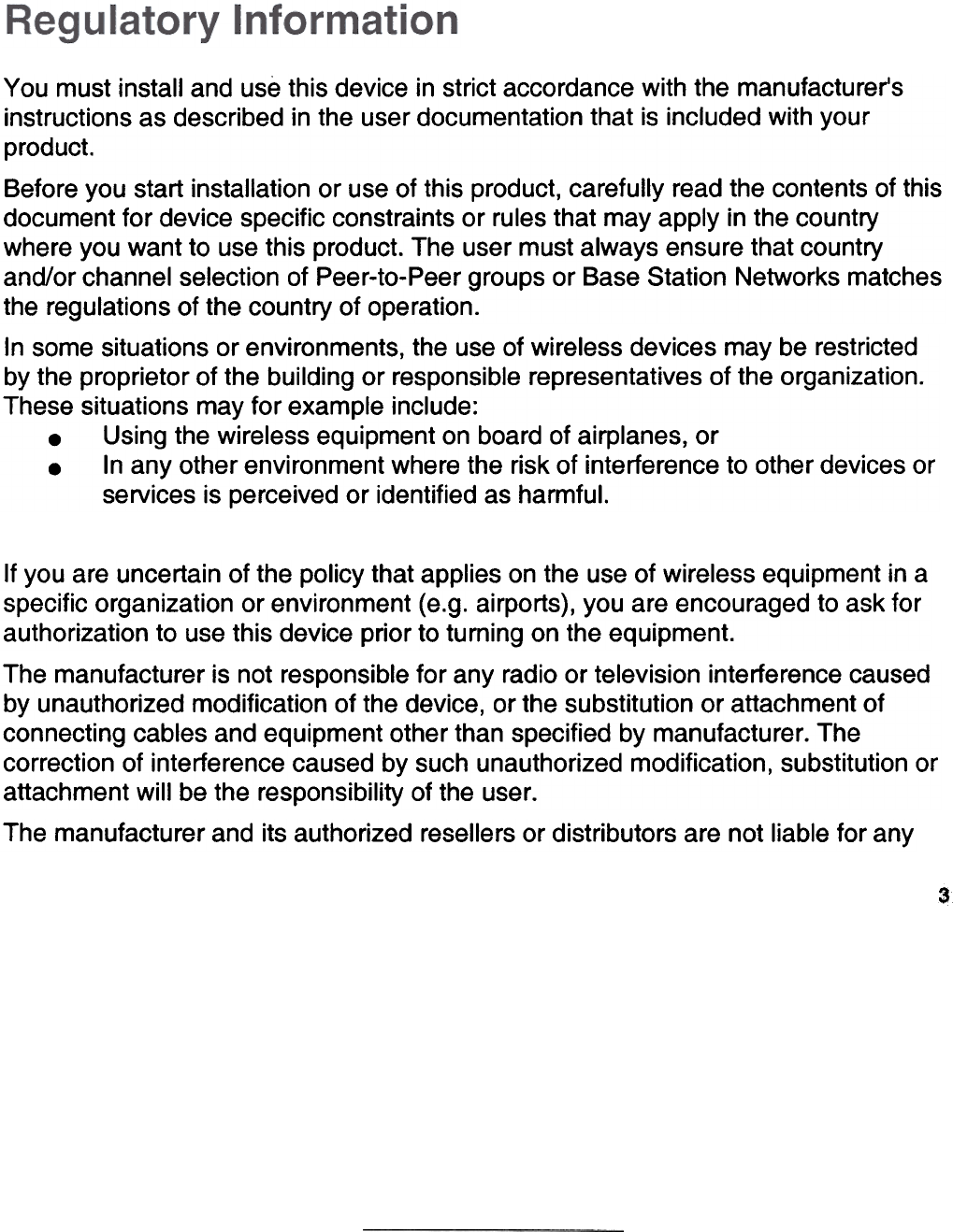
You must install and use this device in strict accordance with the manufacturer's
instructions as described in the user documentation that is included with your
product.
Before you start installation or use of this product, carefully read the contents of this
document for device specific constraints or rules that may apply in the country
where you want to use this product. The user must always ensure that country
and/or channel selection of Peer-to-Peer groups or Base Station Networks matches
the regulations of the country of operation.
In some situations or environments, the use of wireless devices may be restricted
by the proprietor of the building or responsible representatives of the organization.
These situations may for example include:
. Using the wireless equipment on board of airplanes, or
. In any other environment where the risk of interference to other devices or
services is perceived or identified as harmful.
It you are uncertain ot the policy that applies on the use ot wireless equipment in a
specitic organization or environment (e.g. airports), you are encouraged to ask tor
authorization to use this device prior to turning on the equipment.
The manufacturer is not responsible tor any radio or television interference caused
by unauthorized modification of the device, or the substitution or attachment of
connecting cables and equipment other than specified by manufacturer. The
correction of interference caused by such unauthorized modification, substitution or
attachment will be the responsibility of the user.
The manufacturer and its authorized resellers or distributors are not liable tor any
3
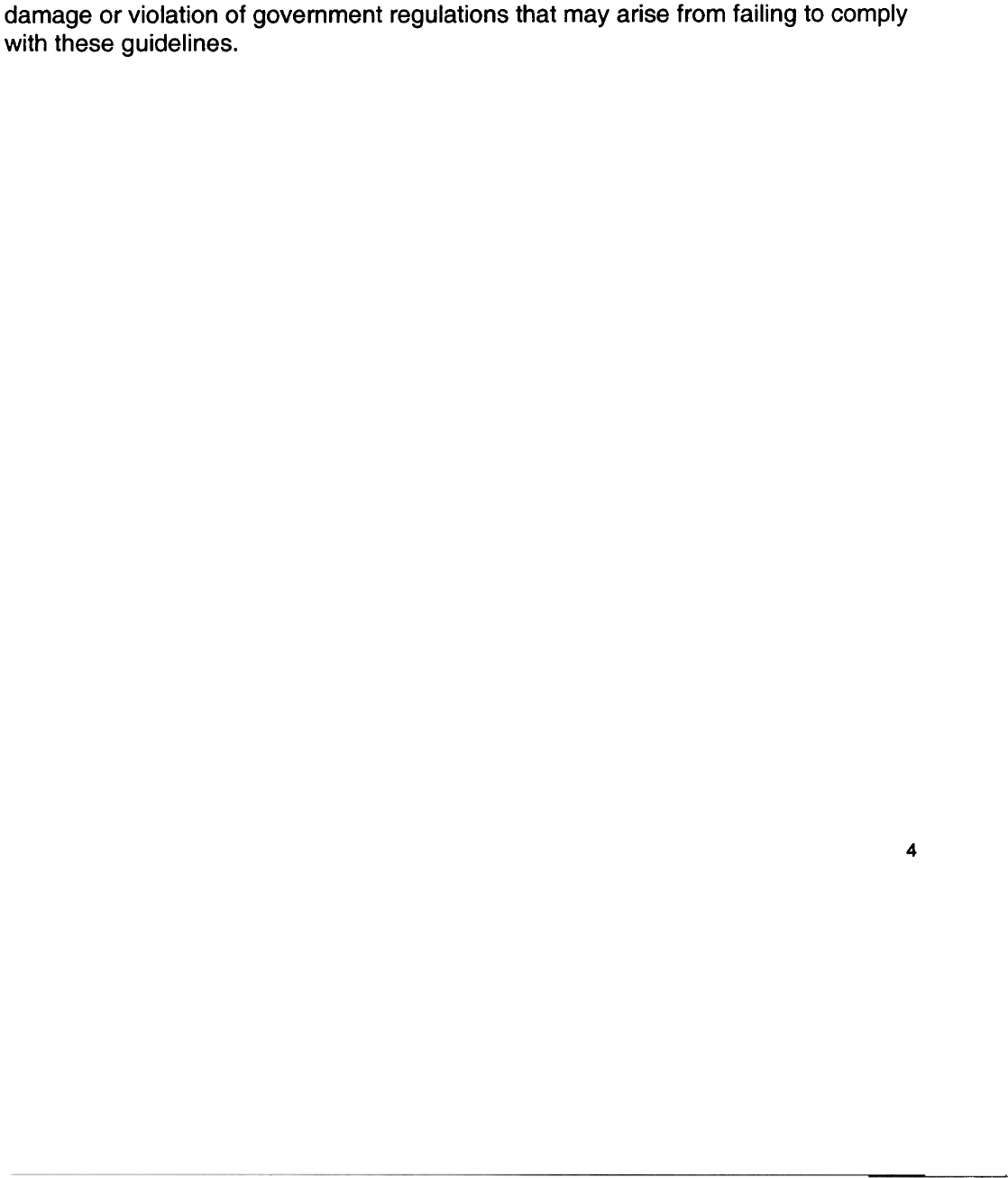
damage or violation ot government regulations that may arise trom tailing to comply
with these guidelines.
4
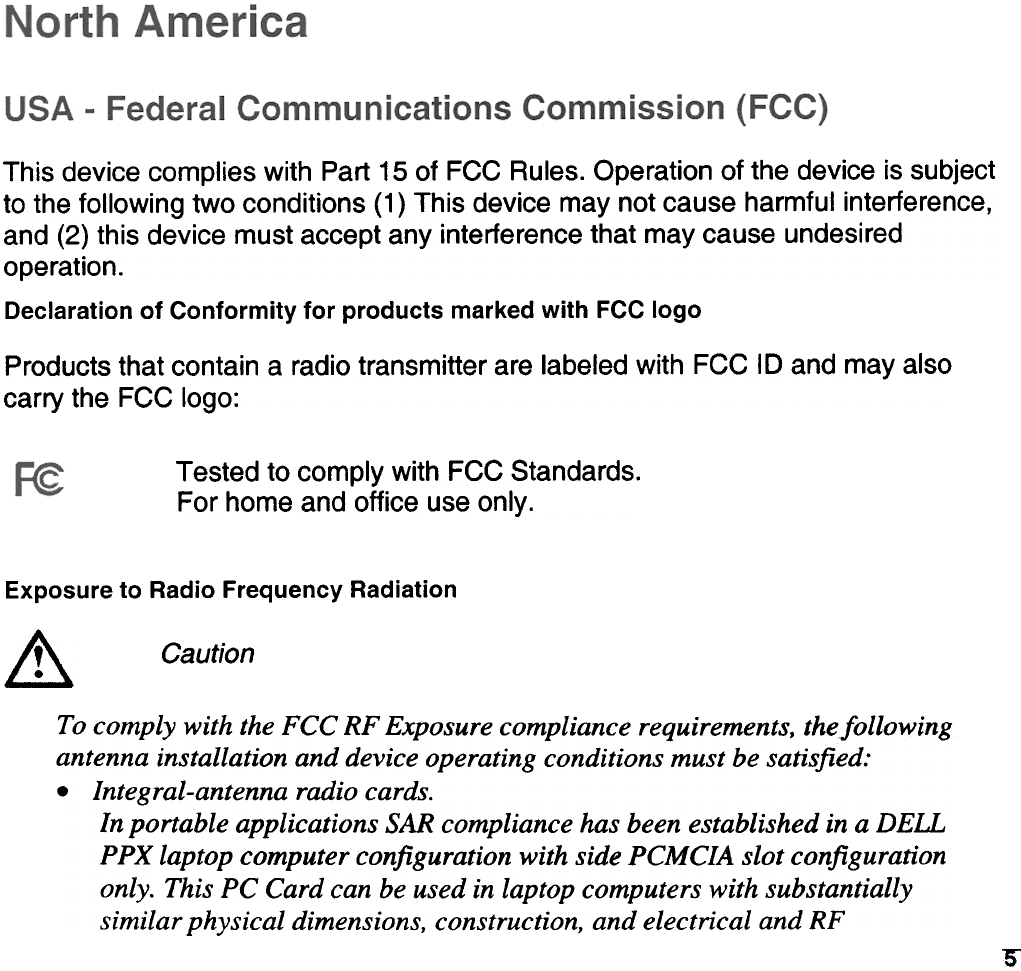
This device complies with Part 15 of FCC Rules. Operation of the device is subject
to the following two conditions (1) This device may not Gauge harmful interference,
and (2) this device must accept any interference that may Gauge undesired
operation.
Declaration of Conformity for products marked with FCC logo
Products that contain a radio transmitter are labeled with FCC 10 and mayalso
carry the FCC logo:
Tested to comply with FCC Standards.
For home and office use only.
Exposure to Radio Frequency Radiation
.& Caution
To comply with the FCC RF Exposure compliance requirements, thefollowing
antenna installation and device operating conditions must be satisfied:
. Integral-antenna radio cards.
In portable applications SAR compliance kas been established in a DELL
PPX laptop computer configuration with side PCMCIA slot configuration
only. This PC Card can be used in laptop computers with substantially
similar physical dimensions, construction, and electrical and RF
:s-
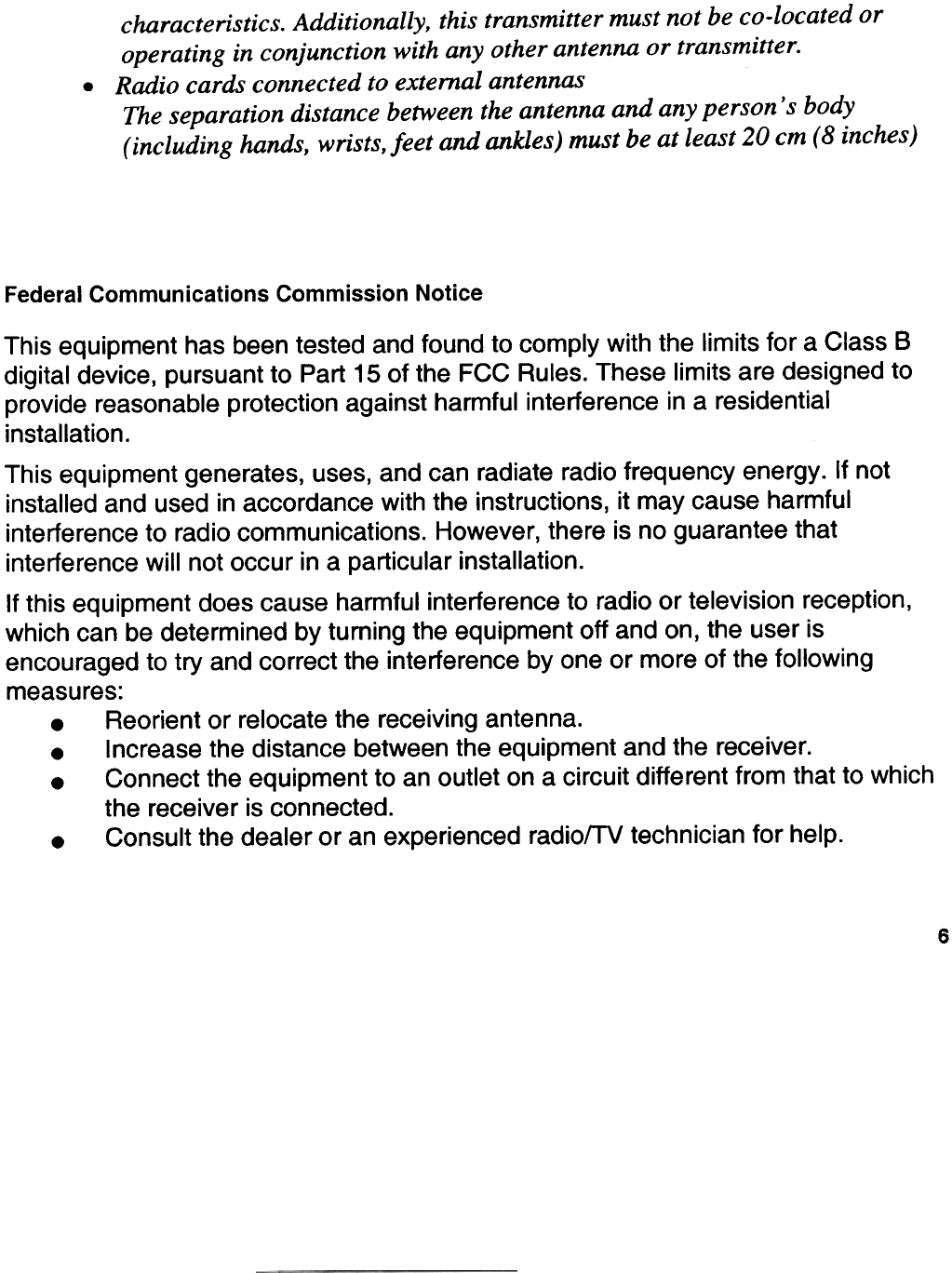
.
characteristics. Additionally, this transmitter must not be co-located or
operating in conjunction with any other antenna or transmitter.
Radio cards connected to extemal antennas
The separation distance between the antenna and any person ' s body
(including hands, wrists, leef and ankles) must be at least 20 cm (8 inches)
Federal Communications Commission Notice
This equipment has been tested and found to comply with the limits tor a Class B
digital device, pursuant to Part 15 of the FCC Rules. These limits are designed to
provide reasonable protection against harmful interference in a residential
installation.
This equipment generates, uses, and can radiate radio frequency energy. If not
instalied and used in accordance with the instructions, it may cause harmful
interference to radio communications. However, there is no guarantee that
interference wijl not occur in a particular installation.
It this equipment does cause harmtul interference to radio or television reception,
which can be determined by tuming the equipment off and on, the user is
encouraged to try and correct the interference by one or more ot the tollowing
measures:
. Reorient or relocate the receiving antenna.
. Increase the distance between the equipment and the receiver.
. Connect the equipment to an outlet on a circuit different trom that to which
the receiver is connected.
. Consult the dealer or an experienced radiofTV technician tor help.
6
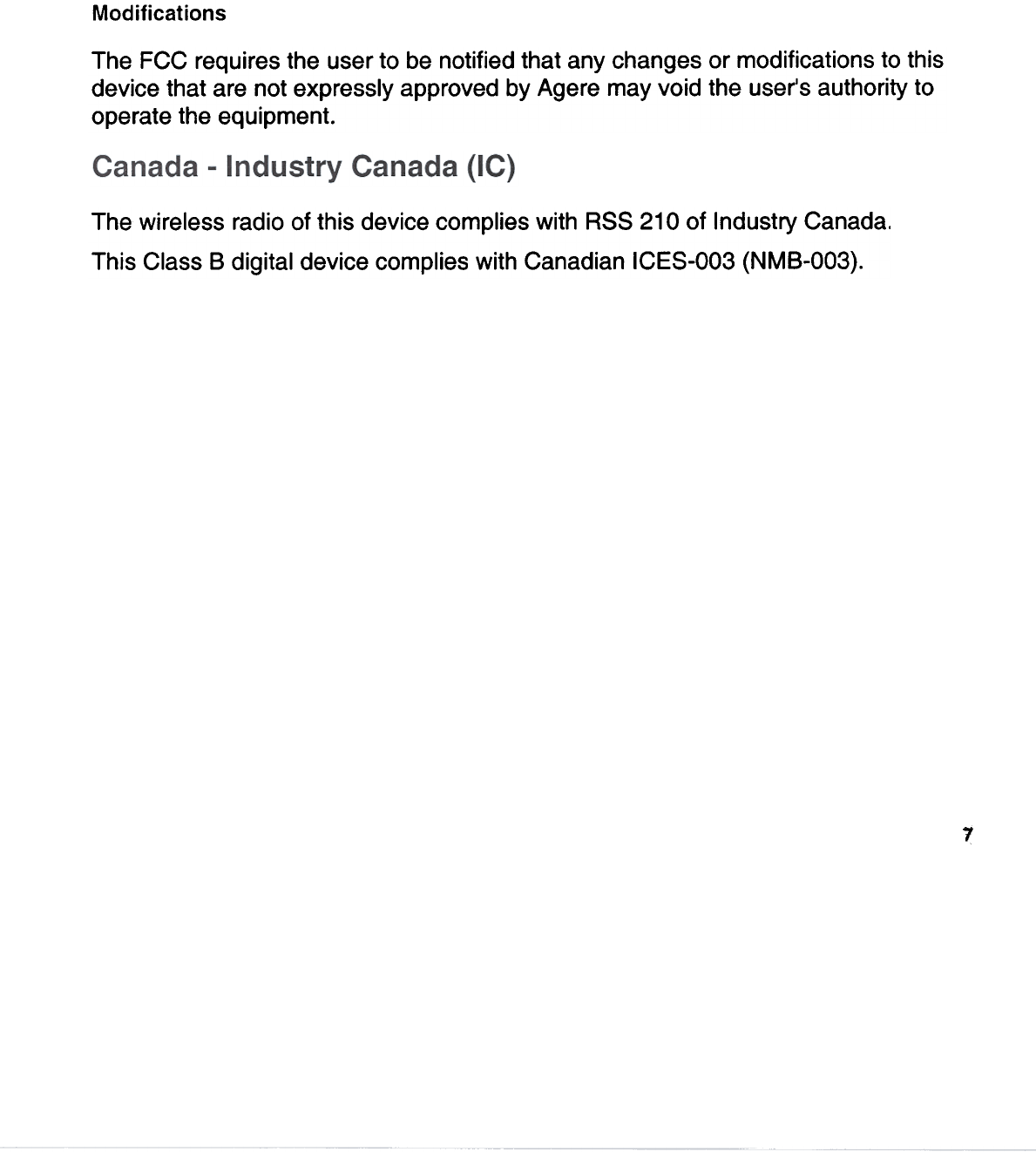
Modifications
The FCC requires the user to be notified that any changes or modifications to this
device that are not expressly approved by Agere may void the userls authority to
operate the equipment.
The wireless radio of this device complies with RSS 210 of Industry Canada.
This Class B digital device complies with Canadian ICES-OO3 (NMB-OO3).
7

This product complies with the essential requirements and provisions
of the R& TTE Directive (1999/5/EC).
Compliance with this directive implies conformity to the following
European Norms:
. EN 60950 - Product Safety
. EN 300 328 Technical requirements tor radio equipment.
. EN 301 489-17 EMC requirements tor radio equipment.
For country specific restrictions, consult the section Radio Approvals
(p. 12) .
8

Association of Radio Industries and Businesses (ARIB)
STD- TGG Notice
Products with the Telec approval marking have been classified as a
"second generation low-power data communication system",
conforming to the Terminal Equipment Technology Standard set out
in the "Law Concerning Electrical Communications Enterprises" and
"Law Concerning Electromagnetic Waves".
This product uses Direct Sequence Spread Spectrum (DSSS)
modulation and radio frequencies in the 2.400-2.483 MHz band
This frequency band is also used by industrial, scientific and medical equipment,
such as:
. Microwave ovens
. Mobile Object Identification Systems (RF-IO) including both:
. Premises radio systems that require a license, or
. Specified low power radio stations tor factory production lines that
do not require a license.
Before using this equipment,
9

.
.
Make sure that you do not use your wireless LAN equipment in the vicinity
of a Mobile Object Identification System (RF-IO). The range of possible
interference is 40 m.
In case RF interference occurs to a Mobile Object Identification System
(RF-IO), stop emitting radio signals or change the active frequency channel
of your equipment. In case RF interference occurs to a licensed Mobile
Object Identification System stop emitting radio signals immediately.
If you have a problem with your wireless equipment, such as interference
trom your equipment to a Mobile Object Identification System (RF-IO),
contact your authorized reseller or manufacturer.
.
Im AII products with the VCCI marking are class B products that comply
with the standard ot the Voluntary Control Council tor Interference
trom Intormation Technology Equipment (VCCI). It this product is
used near a radio or television receiver in a domestic environment, it
may cause radio interference. Install and use the equipment
according to the instruction manual.
10
